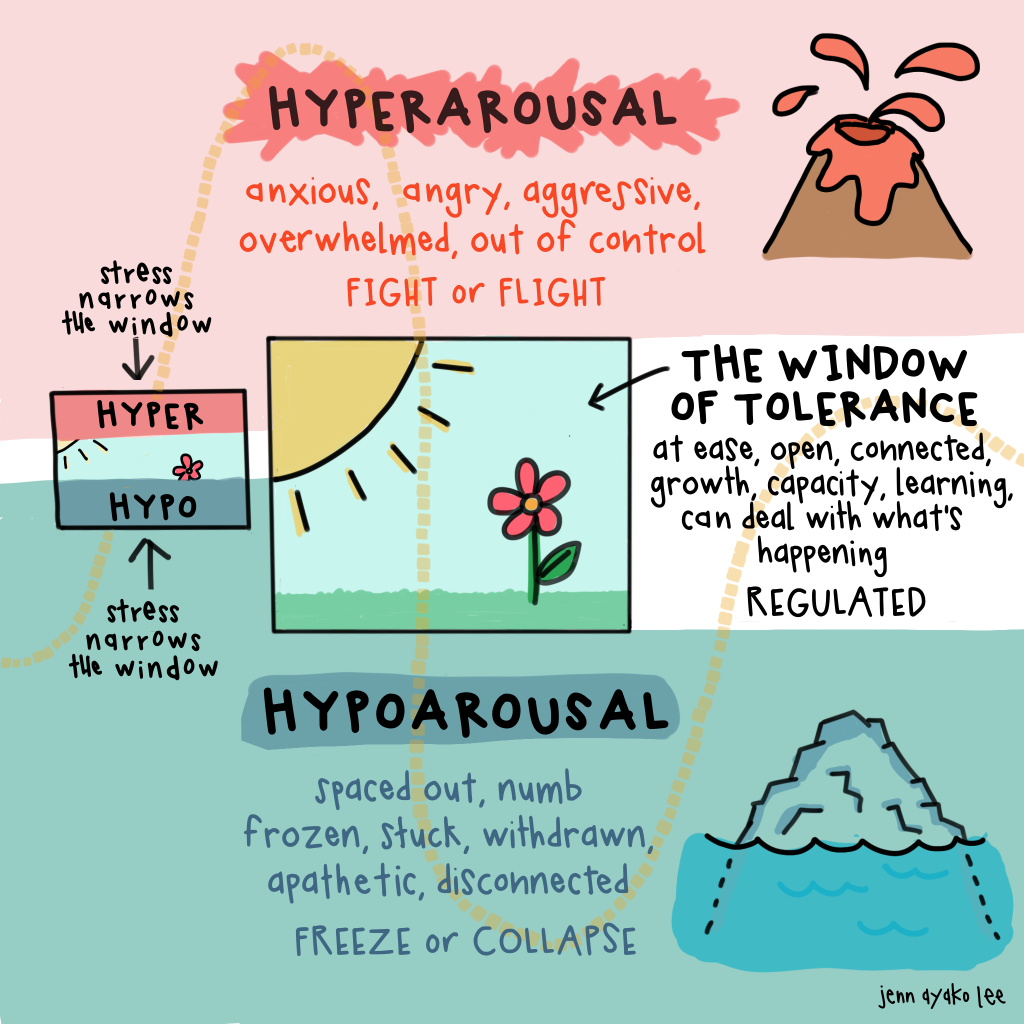
As a sensitive, creative type, I imagine there are times when you might find yourself spinning in a chaotic whirlwind of ideas, inspiration or excitement to the point where you’re feeling overwhelmed or anxious or like you’re working non-stop to stay on top of it all.
Other times you might find yourself feeling shut down, frozen with fear or indecision, exhausted or unable to take action. It might sound like, “I know I need to reach out to that person who called the other day, but I just can’t find it in me to pick up the phone. I guess I’ll just go binge watch my favorite show instead.”
The life of a creative, empathic person can be a lot like riding a roller coaster at times.
Wouldn’t it be so nourishing and supportive to access grounding and spaciousness even amidst life’s inevitable ups and downs?
If you’re not already familiar with the Window of Tolerance, I thought I’d share a little bit about it here. It’s a tool that I’ve found helpful both personally and professionally and the clients that I’ve shared it with have found it useful, too. Dr. Dan Siegel’s Window of Tolerance concept describes the ideal range of arousal in which someone can function most effectively. In this state of autonomic nervous system regulation, we feel at ease and open and we feel capable of taking on what is happening. It doesn’t mean that life is without challenges, pressure or stress or that were not allowing ourselves to feel the natural responses of emotions like anger, fear or sadness when we’re being threatened or feel unsafe or disappointed. It means that when we are in our “window” we are calm and regulated enough to ride the waves and emotions won’t overwhelm or flood us, instead our emotions can inform us to take more intentional and mindful action.
I’ve also heard this model described as the Window of Transformation (by Kai Cheng Thom used in the context of social change and interpersonal conflict resolution ) and the Window of Capacity. These alternate names actually have a more generative ring to me. Being in our window is a place of growth, learning, well-being, flow and connection – a fabulous place to create from, wouldn’t you say?

It doesn’t have to take much to bump us above or below our window. Maybe you receive some complaints or critical feedback about a project near and dear to your heart, or you have difficult interaction with a family member or colleague. We can get bumped up to hyperarousal (sympathetic response) where we may experience things like irritation, anxiety, anger, or overwhelm. Our body’s automatic response in this state is fight or flight.
Other times our bodies may go into a place of shut down to protect ourselves from perceived threats. We get bumped down into hypoarousal (parasympathetic response) where we may experience things like numbness, exhaustion, spaciness, stuckness, apathy, or disconnection. Our body’s automatic response in this state is to freeze.
It’s natural for us to experience some degree of these ups and downs throughout the day (like that yellow line in the doodle above). What’s key is that we know how to both widen and return to our window with more agility.
Our window of tolerance narrows under stress or trauma. BTW, trauma doesn’t need to be a big event that happened. Rather, it’s an emotional response to any event or experience that is distressing or disturbing to you (i.e., too much, too fast, too soon) and that is relative. Also, keep in mind that things like the pandemic, climate crisis, racism, social injustice, patriarchy and war are collective traumas. So, yep, it’s really no surprise if you’re feeling extra stressed these days!
Our window of tolerance widens with awareness and understanding of what our nervous system is doing (on its own accord). Mindfulness and mediation have been shown to help with this. It’s also good to get support from professionals and to connect with and surround ourselves with people who nourish us and help bring a sense of safety. Connecting with nature can also be very regulating, which was a big reason for my move to Hawaiʻi.
Some questions for reflection:
What do you know about the things that can bump you into hyperarousal (or fight/flight) and/or hypoarousal (or freeze)? What are your common triggers and how can you be more mindful of them?
What are the practices, resources, places, tools or activities that bring you back into a state of ease, resilience, openness and flow? Do you need help with identifying more of these? And when you’re in your Window of Tolerance, what is more available to you in your life and creative work? What’s possible from there?
If you’d like to learn more about these concepts, this animated video does an excellent job of describing the Autonomic Nervous System and how it relates to flight, fight, freeze. My fellow right-brainers will appreciate the visuals! It focuses on trauma but you can substitute chronic stress for trauma as well. While it doesn’t name the Window of Tolerance directly, it still maps nicely to it. Also, I like that it really shows how our reactions to stress are at the biological level and that there are some simple practices to help. I also find Deb Dana’s work on Polyvagal Theory and the Autonomic Nervous System to be quite accessible and informative. Here’s a great podcast episode with her.
May these tips and resources help you find and keep more flow and resiliency in your creative work and life.





